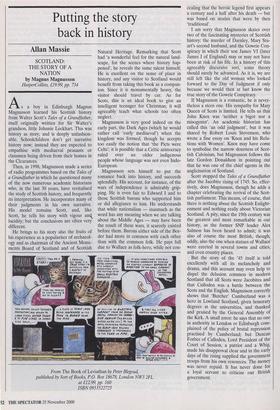Putting the story back in history
Allan Massie
SCOTLAND: THE STORY OF A NATION by Magnus Magnusson HarperCollins, £19.99, pp. 734 As a boy in Edinburgh Magnus Magnusson learned his Scottish history from Walter Scott's Tales of a Grandfather, itself originally written for Sir Walter's grandson, little Johnnie Lockhart. This was history as story, and is deeply unfashion- able. Schoolchildren don't get narrative history now; instead they are expected to empathise with mediaeval peasants or clansmen being driven from their homes in the Clearances.
Then, in 1998, Magnusson made a series of radio programmes based on the Tales of a Grandfather in which he questioned many of the now numerous academic historians who, in the last 30 years, have revitalised the study of Scottish history, and frequently its interpretation. He incorporates many of their judgments in his own narrative. His model remains Scott, and, like Scott, he tells his story with vigour anck lucidity; but the conclusions are often very different.
He brings to his story also the fruits of his experience as a populariser of archaeol- ogy and as chairman of the Ancient Monu- ments Board of Scotland and of Scottish Natural Heritage. Remarking that Scott had 'a wonderful feel for the natural land- scape, for the scenes where history hap- pened', he reveals the same talent himself. He is excellent on the sense of place in history, and any visitor to Scotland would benefit from taking this book as a compan- ion. Since it is monumentally heavy, the visitor should travel by car. As for Scots, this is an ideal book to give an intelligent teenager for Christmas; it will agreeably teach what schools too often neglect.
Magnusson is very good indeed on the early part, the Dark Ages (which he would rather call 'early mediaeval') when the kingdom was formed, though he accepts too easily the notion that 'the Picts were Celts'; it is possible that a Celtic aristocracy ruled over an older indigenous people whose language was not even Indo- European.
Magnusson sets himself to put the romance back into history, and succeeds splendidly. His account, for instance, of the wars of independence is admirably grip- ping. He is even fair to Edward I and to those Scottish barons who supported him or did allegiance to him. He understands that while nationalism — inasmuch as the word has any meaning when we are talking about the Middle Ages — may have been the result of these wars, it scarcely existed before them. Barons either side of the Bor- der had more in common with each other than with the common folk. He pays full due to Wallace as folk-hero, while not con- From The Book of Leviathan by Peter Blegvad, published by Sort of Books, P.O. Box 18678, London NW3 2FL at £12.99, pp. 160 ISBN 0953522725 cealing that the heroic legend first appears a century and a half after his death — but was based on stories that were by then `traditional'.
I am sorry that Magnusson skates over two of the fascinating mysteries of Scottish history: the murder of Darnley, Mary Stu- art's second husband, and the Gowrie Con- spiracy in which their son James VI (later James I of England) may or may not have been at risk of his life. In a history of this agreeably discursive sort, some theory should surely be advanced. As it is, we are still left like the old woman who looked forward to the Day of Judgment if only because we would then at last know the true story of the Gowrie Conspiracy.
If Magnusson is a romantic, he is never- theless a stern one. His sympathy for Mary Queen of Scots is limited. He tells us that John Knox was 'neither a bigot nor a misogynist'. An academic historian has called this 'an odd judgment', but it was shared by Robert Louis Stevenson, who wrote a fine essay on 'Knox and his Rela- tions with Women'. Knox may have come to symbolise the narrow dourness of Scot- tish Calvinism, but Magnusson follows the late Gordon Donaldson in pointing out that he was one of the chief agents in the anglicisation of Scotland.
Scott stopped the Tales of a Grandfather after the Jacobite rising of 1745. So, effec- tively, does Magnusson, though he adds a chapter celebrating the revival of the Scot- tish parliament. This means, of course, that there is nothing about the Scottish Enlight- enment and nothing really about Victorian Scotland. A pity, since the 19th century was the greatest and most remarkable in our history, as the former SNP leader Alex Salmon has been heard to admit; it was also of course the most British, though, oddly, also the one when statues of Wallace were erected in several towns and cities, and even country places.
But the story of the '45 itself is told excellently with all its melancholy and drama, and this account may even help to dispel the delusion common in modern Scotland that all Scots were Jacobites and that Culloden was a battle between the Scots and the English. Magnusson correctly shows that 'Butcher' Cumberland was a hero in Lowland Scotland, given honorary degrees at the universities, and thanked and praised by the General Assembly of the Kirk. A small error: he says that no one in authority in London or Edinburgh com- plained of the policy of brutal repression practised by Cumberland; but Duncan Forbes of Culloden, Lord President of the Court of Session, a patriot and a Whig, made his disapproval clear and in the early days of the rising supplied the government troops from his own resources. The money was never repaid. It has never done for a loyal servant to criticise our British government.





























































































 Previous page
Previous page